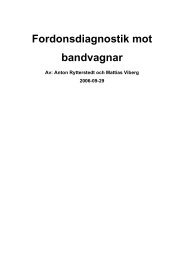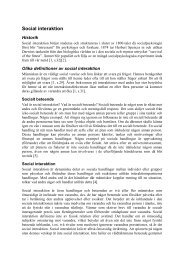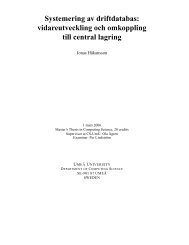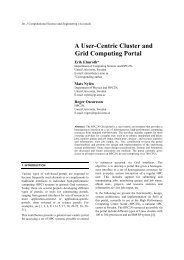Integrated Systems and their Impact on the Future of Positioning ...
Integrated Systems and their Impact on the Future of Positioning ...
Integrated Systems and their Impact on the Future of Positioning ...
You also want an ePaper? Increase the reach of your titles
YUMPU automatically turns print PDFs into web optimized ePapers that Google loves.
maps will be c<strong>on</strong>sidered for l<str<strong>on</strong>g>and</str<strong>on</strong>g> vehicle navigati<strong>on</strong>, <str<strong>on</strong>g>and</str<strong>on</strong>g> pedometers, magnetic<br />
compasses, digital maps, <str<strong>on</strong>g>and</str<strong>on</strong>g> cellular ph<strong>on</strong>es for backpack systems.<br />
The integrati<strong>on</strong> <strong>of</strong> <strong>the</strong> navigati<strong>on</strong> technologies (GPS, INS, <str<strong>on</strong>g>and</str<strong>on</strong>g> visi<strong>on</strong>-based<br />
technologies) with navaids provides a system that has superior performance in<br />
comparis<strong>on</strong> with ei<strong>the</strong>r a GPS, an INS, or visi<strong>on</strong>-based st<str<strong>on</strong>g>and</str<strong>on</strong>g>-al<strong>on</strong>e system. For<br />
instance, GPS derived positi<strong>on</strong>s have approximately white noise characteristics over <strong>the</strong><br />
whole frequency range. The GPS-derived positi<strong>on</strong>s <str<strong>on</strong>g>and</str<strong>on</strong>g> velocities are <strong>the</strong>refore<br />
excellent external measurements for updating <strong>the</strong> INS <str<strong>on</strong>g>and</str<strong>on</strong>g> providing <strong>the</strong> imaging<br />
sensors with positi<strong>on</strong> parameters, thus improving its l<strong>on</strong>g-term accuracy. Similarly, <strong>the</strong><br />
INS can provide precise positi<strong>on</strong> <str<strong>on</strong>g>and</str<strong>on</strong>g> velocity data for GPS signal acquisiti<strong>on</strong> <str<strong>on</strong>g>and</str<strong>on</strong>g><br />
reacquisiti<strong>on</strong> after outages <str<strong>on</strong>g>and</str<strong>on</strong>g> <strong>the</strong> orientati<strong>on</strong> parameters for <strong>the</strong> visi<strong>on</strong>-based system.<br />
The visi<strong>on</strong>-based system can be used as a backup navigati<strong>on</strong> system <str<strong>on</strong>g>and</str<strong>on</strong>g> to update <strong>the</strong><br />
INS data if <strong>the</strong> GPS signal is blocked for l<strong>on</strong>g periods. In general, <strong>the</strong> fact that<br />
redundant measurements are available for <strong>the</strong> determinati<strong>on</strong> <strong>of</strong> <strong>the</strong> vehicle trajectory<br />
parameters greatly enhances <strong>the</strong> reliability <strong>of</strong> <strong>the</strong> system.<br />
The navigati<strong>on</strong> states vector (positi<strong>on</strong>, velocity, <str<strong>on</strong>g>and</str<strong>on</strong>g> attitude) can be determined by<br />
judicially combining elements <strong>of</strong>: navigati<strong>on</strong> technologies (e.g. GPS, Inertial, <str<strong>on</strong>g>and</str<strong>on</strong>g><br />
visi<strong>on</strong>-based) <str<strong>on</strong>g>and</str<strong>on</strong>g> navigati<strong>on</strong> aids (e.g. distance, velocity, <str<strong>on</strong>g>and</str<strong>on</strong>g> attitude sensors). This is<br />
shown in Figure (2) where <strong>the</strong> navigati<strong>on</strong> technologies <str<strong>on</strong>g>and</str<strong>on</strong>g> navaids are listed in two<br />
blocks. Table (1) lists current <str<strong>on</strong>g>and</str<strong>on</strong>g> possible integrated systems scenarios. Table (2) lists<br />
which sub-vectors <strong>of</strong> <strong>the</strong> Navigati<strong>on</strong> State that can be obtained with <strong>the</strong>se systems<br />
scenarios <str<strong>on</strong>g>and</str<strong>on</strong>g> which characteristics <str<strong>on</strong>g>and</str<strong>on</strong>g> <strong>the</strong> resulting integrated system will have.<br />
Possible applicati<strong>on</strong>s are <strong>the</strong>n given in <strong>the</strong> last column.<br />
The Tables indicate that a wide variety <strong>of</strong> integrati<strong>on</strong> strategies can be implemented.<br />
Each has its own characteristics <str<strong>on</strong>g>and</str<strong>on</strong>g> <strong>the</strong> choice <strong>of</strong> a specific system will be based <strong>on</strong><br />
system requirements <str<strong>on</strong>g>and</str<strong>on</strong>g> applicati<strong>on</strong>s. Although it is possible to integrate any set <strong>of</strong><br />
technologies, <strong>the</strong> integrati<strong>on</strong> <strong>of</strong> GPS <str<strong>on</strong>g>and</str<strong>on</strong>g> INS represents <strong>the</strong> core <strong>of</strong> for any integrated<br />
systems where reliability <str<strong>on</strong>g>and</str<strong>on</strong>g> versatility are <strong>the</strong> major issues. The low cost <strong>of</strong> GPS<br />
receivers, <strong>the</strong> coverage <str<strong>on</strong>g>and</str<strong>on</strong>g> reliability <strong>of</strong> GPS, <str<strong>on</strong>g>and</str<strong>on</strong>g> <strong>the</strong> expected decrease in cost <strong>of</strong><br />
MEMS-based inertial sensors make GPS <str<strong>on</strong>g>and</str<strong>on</strong>g> INS <strong>the</strong> logical technologies for realizing<br />
<strong>the</strong> benefits <strong>of</strong>fered by integrated positi<strong>on</strong>ing systems. Many companies are currently<br />
working <strong>on</strong> <strong>the</strong> integrati<strong>on</strong> <strong>of</strong> MEMS based IMU with GPS, with projecti<strong>on</strong>s <strong>of</strong> size,<br />
weight <str<strong>on</strong>g>and</str<strong>on</strong>g> power at 2 x 2 x 0.5 cm, 5 g, <str<strong>on</strong>g>and</str<strong>on</strong>g> less than 1 W for implementati<strong>on</strong> at <strong>the</strong><br />
ASIC level. Figure 3, shows typical performances for some <strong>of</strong> <strong>the</strong> scenarios listed in<br />
Table 1.















